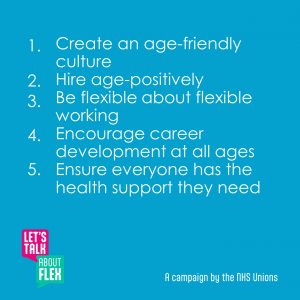20 May 2024
Growing the older workforce within the NHS

With high proportions of older workers as well as challenges around productivity and flexible working, there’s lots of good reasons why NHS Trusts should embrace becoming age-friendly employers, writes Tracy Riddell from the Centre for Ageing Better.
The workplace does not look the same as it did 20 years ago – and neither does the workforce. Today, there are almost 11 million workers aged 50 or over in the UK. That’s a third of all workers and four million more than 20 years ago.
The growing proportion of older workers is readily apparent in the NHS where nearly one in two staff across the UK (47%) is aged 45 or over – rising to three in five specialist doctors and consultants over the age of 45.
Older workers provide balance, and diversity to a multigenerational workforce, which is proven to be more productive and innovative.
Raising plateauing productivity levels is a national priority but has become a particular issue for the NHS which is treating fewer patients than before the pandemic despite having much higher funding and staffing. The issue was also a key focus of Chancellor Jeremy Hunt’s Spring Budget this year.
However, work for those who choose longer working lives is not without its challenges.
Challenges….and age discrimination
Many of those who fall out of the labour market in their 50s and 60s do so, because of caring responsibilities, or health issues. Burnout can be a significant factor behind losing experienced members of staff in high stress working environments such as the NHS.
A lack of flexibility in the workplace and age discrimination in hiring practices can mean that once they have left the labour market, people in their 50s and 60s struggle to return.
Others may leave the workplace before they really want to; dropping out of work entirely when the opportunity to scale back hours and resources would have suited them better.
As a result, employers, and the economy as a whole, are missing out on all that older workers can offer.
Unfortunately, it is still the case that too many organizations fail to recognise age within their Diversity and Inclusion (D&I) strategies and therefore are not committing sufficient resource or taking effective action on an issue that is only going to increase in importance as our ageing population grows.
Our State of Ageing report highlights that employment rates among older workers differ vastly between men and women, disabled and non-disabled people and different ethnic groups. Older workers on lower incomes are more likely to be pushed out of work due to poor health, whilst older women are more likely to leave for caring responsibilities.
Concerns have been raised about the “negative culture” around attitudes towards working less than full-time in the NHS with perceptions that people who work less than full-time are “less dedicated or less committed to their career” prominent.
It is important for management at every level of the NHS to help build a culture that dismisses this misconceived view The #TalkAboutFlex campaign, led by NHS unions, is an excellent example of inspiring staff to think differently about flexible ways of working.
Reframing an age-friendly future
Its time to reframe how we think about working in our 50s, 60s and beyond.
Not everyone wants to work longer, but a sizeable proportion of us want to do some work for longer than the society has grown to expect, and for many of us that work needs to be designed differently to the jobs we occupied in our youth. In a nutshell, work needs to be more age-friendly.
Age-friendly employment benefits us all. Age inclusion does not compete with other diversity efforts. Age-friendly policies – like flexible working, open conversations about health, and de-biasing recruitment processes – help everyone. Get it right for older workers, you get it right for everyone.
The Age-friendly Employer Pledge, launched in November 2022, is for all employers who recognise the value and importance of older workers and commit to improving work for people in their 50s and 60s by taking the necessary action to help them flourish in a multigenerational workforce.
Research commissioned by the Centre for Ageing Better, and based on the experience of leading employers, identified five key areas where employers can make changes to create multi-generational workforces:

Employers signing up to the pledge commit to taking one action per year and join a network of around 350 employers who receive a monthly newsletter, invites to regular webinars (covering the five areas of the framework), the opportunity to join our exclusive LinkedIn group, as well as many other benefits.
Since launching, we have convened three webinars on the topic of ‘flexible working’ – including two masterclasses looking at job design and organisational change, with plans to run more as part of our programme of work.
And last year saw the launch of our second Good Recruitment of Older Workers (GROW) guide filled with practical new tools to help reduce age bias in your recruitment process.
Several NHS employers have signed the pledge but with an estimated shortfall in the NHS workforce of between 260,000 and 360,000 in the next 12 years, we believe many more trusts can benefit from joining our growing network of employers who are also starting their learning journey and sharing their experiences as they go.
We are glad to be supporting NHS organisations on their journey to become more age friendly and look forward to learning from best practice and sharing stories of success.
3 ways employers can take action now
- Create more inclusive job ads. Remove stereotypical language and images, be upfront about flexible working options, and be fully transparent on the recruitment process.
- Engage with your 50+ workforce and support all line managers. Promote the flexible working options and make sure line managers are being supported to be confident in having these conversations.
- Be visible with your support. CEO’s and senior managers can use the intranet and internal communications channels to set a firm message of intent about their commitment to age-inclusion. Or maybe attend existing staff networks to listen to the needs and experiences of their workforce. Don’t have a 50+ network? Set one up.